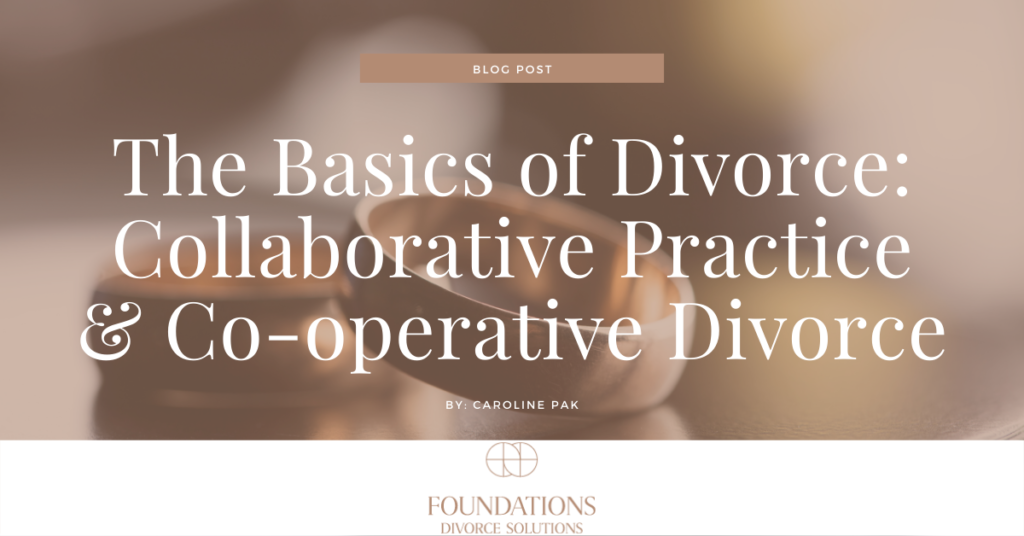Who knew there were so many ways to get a divorce? In this week’s Build Your Foundations, we will look more carefully at the Collaborative Practice and the Cooperative Divorce. Both of these ways to divorce are alternatives to going to litigation and fighting things out before a judge.
The Collaborative Practice
Here are the basics of the Collaborative Practice. Collaborative Practice is a voluntary and non-confrontational process where the spouses agree to work together with their attorneys to come up with a divorce settlement that works for both parties and they agree not to take each other to court. The parties sign a collaborative participation agreement stating that they are choosing to work together with a team of Collaborative Professionals, including their collaboratively trained lawyers, to help them in their divorce negotiation and settlement. Each spouse agrees to share and disclose any information which may be relevant to the divorce and relevant in reaching an amicable settlement. In many Collaborative Practices, there are two attorneys, who represent each of the spouses, a mental health professional, who may help to moderate the meetings, and a financial professional, who serves as a neutral financial resource for both spouses. Within a Collaborative Practice, there may be other professionals who may be a resource to the couple such as a parenting coach, real estate expert, business evaluator, and others. These professionals may be hired to be a neutral or to represent one of the spouses.
Another agreement within the Collaborative Practice is that if the process does not result in a mutually agreed-upon settlement, and the couple chooses to take action within the litigation system, each spouse will now need to find new attorneys and essentially start all over. This part of the agreement is to encourage the couple, as hard as the meetings may get at times, that the team is invested in helping the couple find the right settlement agreement that works for them instead of giving up due to exhaustion and giving up their agency by allowing a judge to make decisions for them, their family, and their futures. Each member of the Collaborative Practice truly wants the couple who are divorcing to be able to come up with a settlement and avoid a trial and the heartaches and cost of trial.
Collaborative Practice Training
What are the requirements to be a part of a Collaborative Team? Anyone who is a part of the Collaborative Practice will have been through specific training to learn about and understand the goal of the Collaborative Practice. Each team member understands the big goal and stays within the objectives to help the clients work through the decision-making process and encourage them to ask for and make choices they feel are beneficial for their family and for them as individuals.
The Pros and Cons
Pros for the Collaborative Practice is simple, you and your soon-to-be ex-spouse are choosing to work amicably and cooperatively towards a divorce settlement that works and benefits you, individually, and your family. You will work with a team of professionals to help guide you through the process of reaching your parenting plan, figuring out which asset division scenario may be the best for you and your soon-to-be ex with the minimal amount of tax consequences and any other pitfalls you may not know to look for. Each of the team members is invested in helping you to come up with a settlement in an amicable and non-confrontational manner.
Cons may be that you are working with a team of professionals and the costs may add up, but the cost will most likely still be less than if you went to trial. As mentioned earlier, if you and your spouse realize that the Collaborative Practice is not working for you to reach a settlement, you will have to start all over with a brand-new team. The cost of money, which now takes away from your final settlement and time to start all over is something to consider if there is any hesitation that the collaborative process may not be or will not be working for you.
The Collaborative Practice is a way to work through your divorce with the understanding that you and your soon-to-be ex-spouse are actively working towards a settlement together. Another con is when the spouses are unable or unwilling to communicate or if there is domestic violence or even suspected domestic violence, whether it be verbal, mental, or physical, or other substance dependency issues, the Collaborative Practice may not be best suited to help you through your divorce. Going to trial may be the best scenario to advocate for the abused party and ensure their needs but mostly their safety is of greatest priority.
What is the difference between a Collaborative Practice versus a Cooperative Divorce?
A Cooperative Divorce may look very similar to the Collaborative Practice with your individual attorneys, a mental health professional, and a financial neutral. Many attorneys will use a mediator to help facilitate the negotiation process where the mediator will shuttle from one spouse and their attorney to the next room with the other spouse and attorney. The key difference is that after working collaboratively to reach agreements for the final settlement if there are areas where agreements cannot be reached, the couple can choose to end the cooperative process and move forward towards a trial. In a Cooperative Divorce scenario, you are not required to retain new attorneys and start all over. The attorneys you and your soon-to-be ex-spouse can continue to work with your attorneys and may now choose to hire a financial professional as an advocate to help you through the process. Also, the agreements you and your spouse choose to keep do not have to be discarded. Only aspects which both parties are unable to agree to can be settled in the courtroom.
Join us in next week’s Build Your Foundations, as we will review mediation, arbitration, and other forms of alternative dispute resolutions (ADRs).




